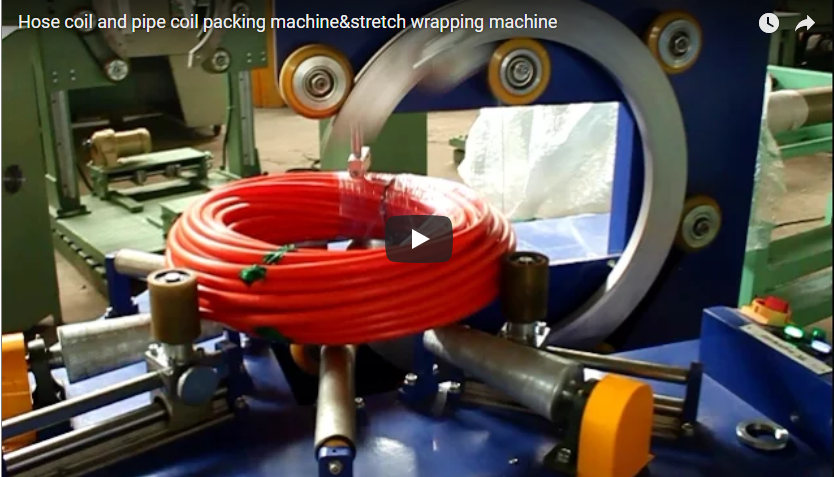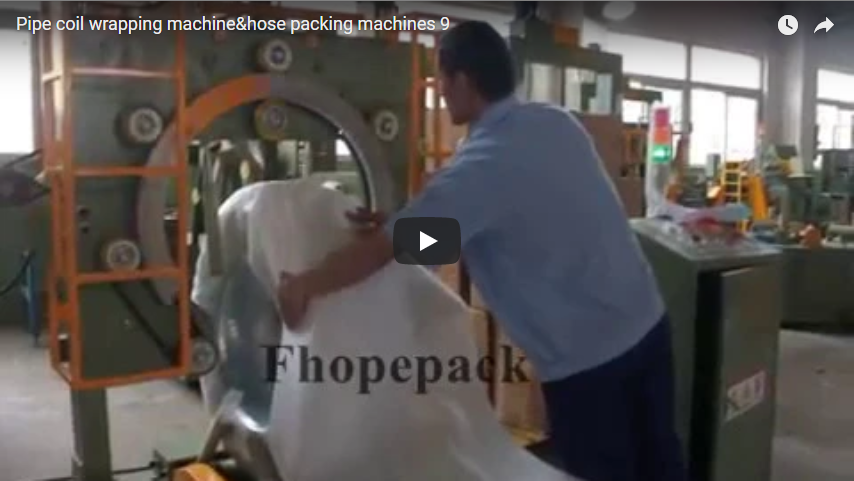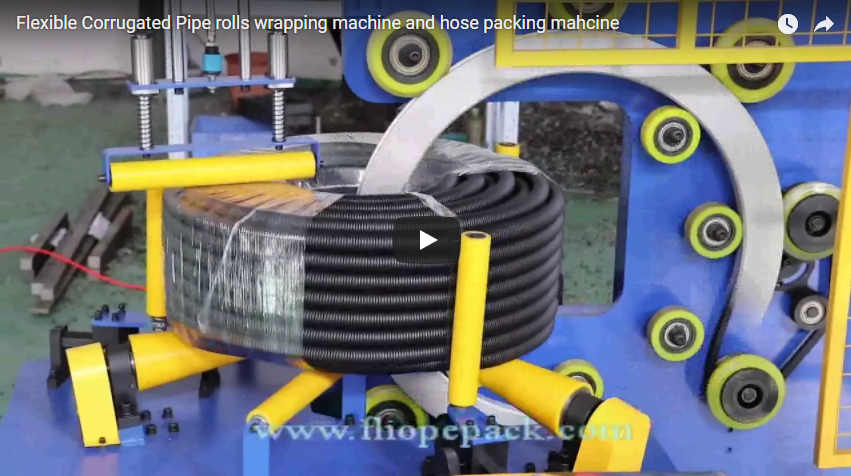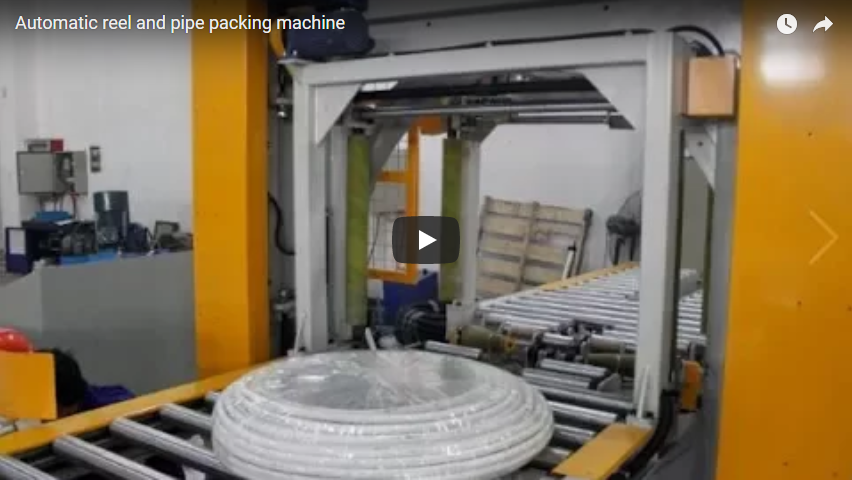The efficient handling and packaging of hydraulic and industrial rubber hoses are critical components in manufacturing and distribution workflows. Manual coiling and packing methods are often time-consuming, labor-intensive, and can lead to inconsistencies in package quality. Automated solutions, such as the Hydraulic Rubber Hose Packing Machine showcased above, offer significant advantages in terms of speed, consistency, and operational efficiency. This article delves into the technical aspects, design considerations, and operational benefits of such machinery, aligning with the rigorous standards expected by Machine Design readers.
1. Core Functionality and Application Scope
At its core, a hydraulic rubber hose packing machine is designed to automatically coil hoses to predetermined lengths and diameters, followed by securing the coil using wrapping materials (like stretch film) or strapping (like PP belts). This automated process caters primarily to medium-to-high volume hose manufacturers and distributors dealing with a variety of hose types, including:
- Hydraulic Hoses ( spełniające normy SAE, EN, ISO)
- Industrial Rubber Hoses (Air, Water, Chemical)
- PVC and Composite Hoses
- Large Diameter Layflat Hoses (in some configurations)
The primary objective is to transform bulk hose lengths into neat, manageable, and protected coils ready for storage, shipment, or further processing.

2. Key Design Principles and Structural Components
The robust performance and reliability of these machines stem from sound engineering design and the integration of durable components. Key elements typically include:
- Heavy-Duty Frame: Constructed from welded structural steel to provide stability and dampen vibrations during high-speed operation. The frame must withstand the dynamic forces of coiling and the static weight of large hose coils.
- Coiling Mechanism: Usually features a driven winding head or mandrel. Precision control over rotation speed and traversing movement is crucial for forming uniform coils. Variable speed drives (VSDs) coupled with servo or vector motors are common for precise speed and tension control. The coiling diameter is typically adjustable to accommodate different product specifications.
- Hydraulic System: Provides the power for clamping, cutting (if integrated), traversing, and potentially lifting/ejecting the finished coil. Key components include a hydraulic power unit (HPU) with pump, motor, reservoir, valves (proportional or servo), and actuators (cylinders). System pressure and flow rates are designed based on the required forces and speeds. Robust filtration and cooling are essential for longevity.
- Control System (PLC): The brain of the operation, typically a Programmable Logic Controller (PLC). It sequences machine operations, monitors sensors (for hose presence, length measurement, safety interlocks), and interfaces with the Human-Machine Interface (HMI). PLCs from manufacturers like Siemens, Allen-Bradley, or Mitsubishi are frequently used, offering flexibility and robust industrial performance.
- Wrapping/Strapping Unit: Integrated system for securing the coil.
- Stretch Wrapping: Employs a rotating ring or arm carrying a stretch film roll, applying film under controlled tension around the coil's circumference.
- Strapping: Uses Polypropylene (PP) or Polyester (PET) straps, automatically feeding, tensioning, sealing (heat or friction weld), and cutting the strap at designated points around the coil.
- Material Handling & Pay-off: Includes inlet guides, tensioning devices, and often an automated cutting system synchronized with the coiling length measurement. An accumulator might be used upstream to allow continuous hose production during the packing cycle downstream. A powered pay-off stand for feeding the hose smoothly into the machine is also a common requirement.
3. Technical Specifications and Performance Data
Engineers evaluating such equipment require specific performance metrics. Below is a typical range of specifications for a mid-range hydraulic hose packing machine (Note: Actual values vary significantly based on model and manufacturer):
- Applicable Hose Diameter Range (ID): 6 mm (1/4") - 51 mm (2")
- Maximum Coil Outer Diameter (OD): 1200 mm
- Adjustable Coil Inner Diameter (ID): 300 mm - 700 mm
- Adjustable Coil Width: 50 mm - 500 mm
- Maximum Coil Weight: 100 kg - 300 kg (model dependent)
- Coiling Speed (Linear Hose Speed): 0 - 80 m/min (Variable via VSD)
- Length Measurement Accuracy: ± 0.1% - 0.5% (using encoder feedback)
- Hydraulic System Working Pressure: 8 - 16 MPa (1160 - 2320 PSI)
- Control System: PLC with Touchscreen HMI
- Wrapping Material: LLDPE Stretch Film (e.g., 500mm width, 23 micron thickness)
- Strapping Material: PP or PET Straps (e.g., 12mm - 16mm width)
- Power Requirements: 5 kW - 15 kW (approx., depending on features)
- Required Air Pressure (Pneumatic Assists): 0.5 - 0.7 MPa (if applicable)
- Machine Footprint (L x W x H): Varies greatly, e.g., 3m x 2m x 2.5m
Comparing these parameters against production needs is crucial for selecting the right machine configuration.
4. Operational Workflow and Automation Advantages
A typical automated packing cycle proceeds as follows:
- Hose Feed: The hose end is manually or automatically fed into the machine's coiling head.
- Parameter Input: Operator sets desired coil length, ID/OD, wrapping/strapping parameters via the HMI.
- Coiling: Machine automatically starts coiling, precisely measuring length using an encoder wheel or similar device. Tension is controlled to ensure a tight, even coil.
- Cutting: Upon reaching the target length, an integrated cutter (hydraulic shear or rotary blade) automatically cuts the hose.
- Securing: The coiling head stops, and the wrapping or strapping unit engages, securing the coil. Multiple straps or complete film wrapping can be applied as programmed.
- Ejection: The finished, secured coil is automatically ejected onto a conveyor, pallet, or collection table.
- Cycle Restart: The machine readies itself for the next cycle.
Key Advantages of Automation:
- Increased Throughput: Significantly faster than manual methods.
- Consistency: Uniform coil dimensions and secure packaging every time.
- Labor Reduction: Frees up personnel for other tasks.
- Improved Safety: Reduces manual handling of heavy hoses and interaction with moving parts.
- Material Savings: Optimized use of wrapping/strapping materials.
- Data Logging: Modern systems can track production data (coils produced, lengths, downtime).
5. Integration into Production Lines and Customization
These machines are rarely standalone units. Effective integration involves:
- Upstream Connection: Synchronizing with hose extrusion lines or cutting machines via accumulators or dancer controls to ensure continuous flow.
- Downstream Handling: Linking with conveyors, palletizers, or AGVs (Automated Guided Vehicles) for seamless transfer of finished coils to warehousing or shipping areas.
- MES/ERP Integration: Connecting the machine's control system to Manufacturing Execution Systems (MES) or Enterprise Resource Planning (ERP) systems for production scheduling, tracking, and inventory management.
Customization Options Often Include:
- Specific coil size ranges beyond standard.
- Integration of labeling or printing units.
- Advanced diagnostic and remote monitoring capabilities.
- Specific safety standard compliance (e.g., CE, UL).
- Configurations for handling different hose rigidities or specialized types.

hose coil wrapping machine by film 6. User Experience and Maintenance Considerations
From a user perspective, ease of operation and maintenance are paramount:
- HMI Design: Intuitive touchscreen interfaces with clear graphics, multi-language support, recipe storage (for different hose types/sizes), and diagnostic screens are essential.
- Changeover Time: Quick-change tooling or adjustments for different hose diameters and coil sizes minimize downtime between production runs.
- Safety Features: Comprehensive guarding, light curtains, emergency stops, and adherence to relevant safety standards (e.g., ISO 13849) are non-negotiable.
- Maintenance: Well-designed machines provide easy access to lubrication points, hydraulic components, sensors, and wear parts. A clear preventive maintenance schedule provided by the manufacturer helps ensure longevity and optimal performance. Regular checks of hydraulic fluid levels and quality, filter conditions, sensor cleanliness, and mechanical fasteners are crucial.
Conclusion
The Hydraulic Rubber Hose Packing Machine represents a significant advancement over manual methods, offering quantifiable benefits in productivity, quality, and safety for hose manufacturers and distributors. Its design integrates robust mechanical structures, precise hydraulic control, and intelligent automation via PLC systems. Understanding the technical specifications, operational workflow, and integration possibilities allows engineers and operations managers to effectively evaluate and implement this technology, optimizing their hose handling and packaging processes. For further information on hydraulic system design principles, resources like the National Fluid Power Association (NFPA) provide valuable industry standards and insights. Careful consideration of machine capabilities against specific production requirements ensures a successful investment in automation.






